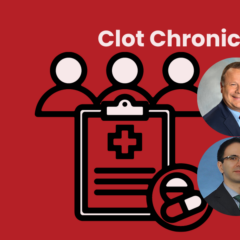Last updated on
Clot Chronicles: Thrombotic Risk and Anticoagulation Benefits in Discharged COVID-19 Patients — The CORE-19 Registry
Hello, I’m Alex Spyropoulos. I’m a Professor of Medicine at the Zucker School of Medicine at Hofstra/Northwell in New York, and I’m here on the Clot Chronicles to discuss the recent publication of our CORE-19 registry study that was published in Blood.
The CORE-19 study was a large, prospective, multicenter registry conducted in our Northwell multihospital health system that examined thromboembolic outcomes and mortality in 4,906 adults in patients that were hospitalized during the first phases of the pandemic from March through May 31st, 2020. It was interesting to note that while blood clots had been observed in COVID-19 patients during their hospitalization, and especially if they were in intensive care unit (ICU) settings, there has been little and very conflicting data on the risk of blood clots such as venous thromboembolism (VTE) and arterial thromboembolism (ATE), including stroke and myocardial infarction, in the post-hospital discharge period.
So, this study, I think importantly, showed 3 key things. The first is that major thromboembolic disease and mortality was much higher than appreciated, so that our CORE-19 registry showed a VTE event rate at 90 days of approximately 1.55%, an ATE rate of 1.71%, and an all-cause mortality (ACM) rate of nearly 5.0% – an overall rate of 7.1% or so of this multicomponent outcome. So that’s the first thing, that the risk of major thromboembolism and death is much higher than appreciated in hospitalized COVID-19 patients.
The other thing that our registry study showed is that several key risk factors for these major thromboembolic events and death were described and independently associated with these outcomes. These factors included advanced age, the presence of cardiovascular risk factors such as coronary artery disease, carotid occlusive disease, and peripheral arterial disease, a personal history of thrombotic disease, chronic kidney disease, a stay in the ICU, and also an elevated VTE risk score, namely the IMPROVE-DD risk score, which has previously been developed and validated by our team and incorporates a fairly new biomarker, an elevated D-dimer, that is able to predict short- to medium-term thrombotic risk.
And the last point of this registry is that the use of post-discharge anticoagulants, mostly in prophylactic doses, reduced the risk of both major thromboembolic events and death by 46%. And indeed, as the major component of this composite outcome was ACM, this finding suggested that since ACM was modifiable by the use of post-discharge extended prophylaxis, that thrombotic mechanisms played a major role for this ACM in the immediate post-discharge period.
So, this is an important study; it’s the largest study, to date, of post-discharge outcomes in hospitalized COVID-19 patients. And in my view, it clearly shows that in patients who were hospitalized with COVID-19 and have these high-risk features, as I mentioned, and are also at low bleeding risk, these patients would benefit from a strategy of post-discharge thromboprophylaxis—preferably with a direct oral anticoagulant—to reduce the risk of major thrombosis and death. Of course, these results need to be verified by randomized controlled trials in the post-discharge periods that are ongoing. Thank you.



